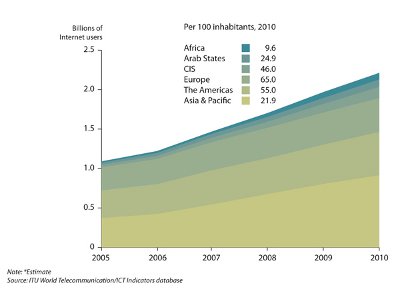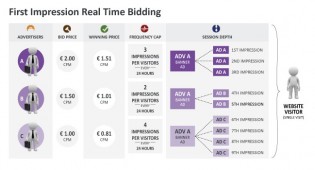UN Agency: More than 2 Billion to be Online by End of 2010

YNOT EUROPE – Access to mobile networks is available to more than 90 percent of the world’s population and 143 countries offer 3G wireless services, leading the International Telecommunication Union to predict the number of internet users worldwide will surpass two billion by the end of 2010. The figure represents one-third of the world’s total population.
ITU, part of the United Nations system, is the main source of internationally comparable data and statistics about information and communication technology (ICT). The Market Information and Statistics Division of the Telecommunication Development Bureau (BDT) collects, harmonizes and disseminates more than 100 telecommunication and ICT indicators from more than 200 economies worldwide.
According to the ITU report The World in 2010: ICT Facts and Figures, published Oct. 19, the number of internet users worldwide doubled in the past five years. The number of people who have internet access at home increased from 1.4 billion in 2009 to almost 1.6 billion by mid-2010. A total of 226 million new users connected to the internet in 2010, 162 million of whom live in developing countries.
By the end of 2010, 71 percent of the population in developed countries will be online, compared to 21 percent in developing countries. While in developed countries 65 percent of people have access to the internet at home, this is the case for only 13.5 percent of people in developing countries, where internet access in schools, at work and in public locations is critical.
Regional differences are significant: 65 percent of Europeans are on the internet, compared to only 9.6 percent of Africans.
With the rapid increase of high-bandwidth content and applications on the internet, there is growing demand for higher-speed broadband connections. ITU considers broadband a catalyst for growth. Recently, ITU and the United Nations Educational Scientific and Cultural Organization launched the Broadband Commission for Digital Development that aims to promote the adoption of broadband-friendly practices and policies worldwide.
“Broadband is the next tipping point, the next truly transformational technology,” ITU Secretary-General Hamadoun Touré said. “It can generate jobs, drive growth and productivity and underpin long-term economic competitiveness. It is also the most powerful tool that we have at our disposal in our race to meet the Millennium Development Goals, the deadline for which is now just five years away.”
Over the past year, fixed broadband subscriptions have seen strong growth, ITU’s report notes. By the end of 2010, fixed broadband penetration will reach 8 percent globally. Penetration levels in developing countries remain low, however: only 4.4 subscriptions per 100 people compared to 24.6 per 100 in developed countries.
While high-speed internet service remains out of reach for many people in low-income countries, mobile telephony is becoming ubiquitous, with access to mobile networks now available to more than 90 percent of the global population. ITU’s new data indicate that among the estimated 5.3 billion mobile subscriptions by the end of 2010, 3.8 billion will be in the developing world.
“Mobile phone penetration in developing countries now stands at 68 percent — higher than any other technology before,” said Sami Al Basheer, director of ITU’s Telecommunication Development Bureau. “These countries have been innovative in adapting mobile technology to their particular needs and will be able to draw even greater benefits from broadband once adequate and affordable access is available.”
In developed countries, growth in mobile subscriptions has slowed considerably during the past five years, with year-over-year growth from 2009 to 2010 of only 1.6 percent. The mobile market in the developed world is reaching saturation levels with 116 subscriptions per 100 inhabitants, on average, according to the ITU report.
At the same time, subscriptions to IMT2000/3G services increased from 72 million in 2005 to 940 million in 2010. As many as 143 countries offer IMT2000/3G services commercially, up from 95 countries in 2007. Over the past year, mobile broadband has experienced steep growth, especially in Europe and the United States, and some countries have started to offer commercial services at even higher broadband speeds, moving to next-generation wireless platforms.
The trend from voice to mobile data applications is reflected in the growing number of SMS, or text messages, sent. SMS volume tripled over the past three years, to 6.1 trillion in 2010. In other words, nearly 200,000 text messages are sent every second.
Overall, the price of ICT services is falling, but high-speed internet access remains prohibitively expensive, especially in low-income developing countries. In 2009, an entry-level fixed broadband connection cost on average 190 PPP$ (purchasing power parity in U.S. dollars) per month in developing countries, compared to only 28 PPP$ in developed countries. Mobile cellular services are much more affordable, with an average monthly cost of 15 PPP$ in developing countries compared to around 18 PPP$ in developed countries. The relative price for ICT services, especially broadband, is highest in Africa, the region with the lowest income levels. Consequently, the region lags when in broadband access adoption. Although subscriptions are increasing, a penetration rate of less than 1 per cent for fixed broadband remains.
Comments are closed.






